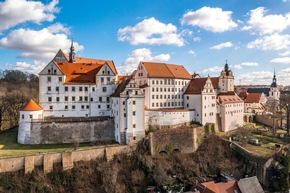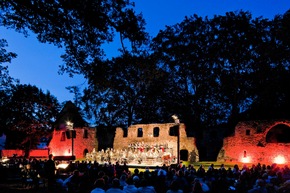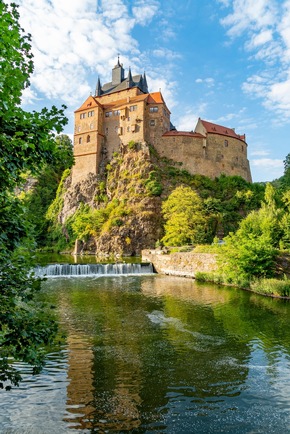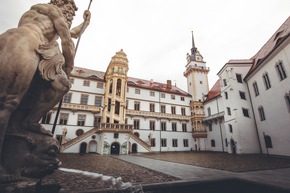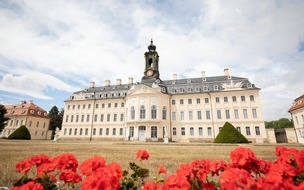Leipzig Tourismus und Marketing GmbH
Experience Castles and Palaces in the Leipzig Region
History Around Every Corner: Experience Beautiful Castles, Palaces and Exceptional Cultural Events in the Leipzig Region
Leipzig is not only worth a visit because of its great tradition as a city of music and its splendid cultural offers, it also surprises with its diverse range of leisure activities in the surrounding area. In the Leipzig region, nature and culture go hand in hand and provide numerous opportunities to combine active holidays with cultural highlights. Culture lovers and history enthusiasts will find an above-average density of imposing castles and magnificent palaces here, some of which have even gone down in European history.
BurgenLandKlänge Concerts – Musical highlights in unique settings
The fact that these culturally and historically interesting buildings are not only witnesses to an eventful past is proven by the wide range of events that attract visitors to the Leipzig region throughout the year. One in particular stands out: The BurgenLandKlänge. The concert series, which takes place from July to December, fills the historic walls of castles and palaces, lovingly restored manor houses, old monasteries, churches, even lake stages/floating stages and quarries with music, making each concert a treat for ears and eyes. Whether to medieval sounds, classical concerts, musical theatre or Nordic folk – there is an event for every taste. Musical and cultural input is provided by the Leipzig Symphony Orchestra, the Saxon Wind Philharmonic, the Central Saxon Summer of Culture and the Central Saxon Theatre, among others. Up to 20 cultural and historical venues are involved each year.
Renaissance Castle Colditz – An eventful history
Colditz Castle in the town of the same name is famous far beyond the borders of Saxony. The magnificent 16th-century building rises on a 30-metre-high rock above the town, even though its origins go back almost 1,000 years. During its eventful history, Colditz Castle served amongst other things as a hunting lodge for the Saxon electors. Large parts of the castle buildings, especially in the princely apartments, have been well preserved.
During the Second World War, Colditz Castle served as a prison camp for Allied officers from Great Britain, the Commonwealth, France, Belgium, Holland and Poland under the name "Oflag IVC". Steep cliffs, barbed wire, guards and searchlight beams gave the prison camp a reputation for being escape-proof. Nevertheless, more than 300 escape attempts from the prison camp were made between 1939 and 1945, 31 of which were successful. The partly spectacular escape attempts were processed after the war in several books ("The Colditz Story") and films ("Colditz - Escape to Freedom"), which made Colditz Castle well known especially in Great Britain. Therefore, it has always attracted visitors from the United Kingdom. The Colditz Castle Escape Museum is dedicated to this exciting part of the castle's history.
There are not only exciting stories about the castle's eventful past that attract visitors to Colditz, but also the diverse calendar of events throughout the year. Music lovers can enjoy the monthly Blüthner concert series "Colditz Classic" in summer as well as various jazz, pop and song evenings. Colditz Castle becomes truly enchanting in early December, offering Yuletide cheer in a historic atmosphere as it stages “Christmas at Colditz Castle”: the rooms and both courtyards are filled with festive decorations, candles and culinary delights. Traditional handicrafts such as wood art, stoneware, handmade paper and soaps, and plenty more are sold in the cellar vaults.
Kriebstein Castle - Saxony's most beautiful knight's castle
About an hour south-east of Leipzig, the Saxon municipality of Kriebstein guards a special treasure: Kriebstein Castle, the most beautiful knight's castle in Saxony. The completely preserved building complex from the late Gothic period has lost none of its beauty since it was built. The monumental residential tower with a height of 45 metres rises from the highest cliff. Visitors can tour the impressive historic monument from the lowest cellar to the historically preserved attic floors and stroll through the furnished like the lords and ladies of a bygone era. Even foreign film crews have come all the way to capture a real medieval feeling here. The castle was used as a model for the internationally awarded film "Grand Budapest Hotel".
After a visit to the impressive building, guests are recommend to make a detour to the scenic Kriebstein Dam, which can be discovered on a circular walking tour or a boat trip. Culture is not neglected here either, as Saxony's only lake stage hosts a wide variety of performances by the Central Saxon Theatre and Cultural Summer from spring to autumn as part of the BurgenLandKlänge festival.
Hartenfels Castle in Torgau – A castle like something out of a fairy tale
Majestically enthroned above the Elbe, it looks as if it has sprung from Grimm's fairy tale: Hartenfels Castle in Torgau is one of the most beautiful castles in Saxony and should not be missed on a visit to the Leipzig region. Built in the early Renaissance period in the 15th and 16th centuries, it was the residence of the Saxon electors for many years. The grand spiral stone in the inner courtyard of the castle, an architectural masterpiece that is definitely worth a visit, also bears witness to the splendour of this period. Torgau was a political centre at the time of the Reformation. Martin Luther stayed in the town more than 60 times and consecrated the Torgau Castle Chapel, the first Protestant church building in the world. Today, Torgau is the most important Luther site in Saxony and is therefore linked to other Reformation sites on the Luther Trail Saxony, a circular hiking trail that connects 27 places in Saxony over a distance of more than 550 kilometres. Torgau also achieved international fame when Russian and American soldiers met on the Elbe on 25 April 1945 and shook hands in friendship. With this symbolic "handshake of Torgau", the gap between the German Eastern and Western fronts closed - visible to the public world - and the end of the Second World War came within reach. At the annual "Elbe Day" in April, Torgau commemorates this historic event with an official act of remembrance, live music and other highlights.
In July, music is in the air in Torgau, when students from international universities and young singers make music and rehearse in the historic old town as part of the International Saxon Singers' Academy at Schloss Hartenfels Torgau. The daily concerts and free lunchtime music are a delight. On the first weekend in October, the town festival "Torgau leuchtet" (Torgau lights up) with light art, concerts, market hustle and bustle and museum night commemorates the inauguration of the Torgau Castle Chapel by Martin Luther. The Torgau Fairytale Christmas Market offers a special ambience against the backdrop of the magnificent Renaissance town hall.
Baroque beauty Hubertusburg Palace in Wermsdorf
Wermsdorf, which was first mentioned in a document in 1206, was a preferred residence for the Saxon rulers due to its scenic landscape and its wide hunting grounds. The famous “Augustus the Strong” (1670 – 1733), elector of Saxony and later King of Poland, commissioned a new hunting lodge in Wermsdorf after the Old Hunting Lodge no longer met his requirements. Thus Hubertusburg Palace was built from 1721 and completely finalized in 1751 as the most magnificent and largest country palace in Europe at the time. Today, the only evidence of the former splendour is the intact Catholic castle chapel of St. Hubertus. Wermsdorf has achieved a special status in European history: The Saxon village was the scene of one of the most important peace negotiations in European history, the "Peace of Hubertusburg", which sealed the end of the Seven Years' War (1756 to 1763).
Until 31 October 2022, the palace will be on display as part of the exhibition "Spaceship Hubertusburg. Dream Castle in Transition". More than 100 exhibits from the Dresden State Art Collections and loans from other Saxon museums are presented. Each exhibition room deals with an episode from the eventful history of the palace. The phase in which Hubertusburg was home to a mental hospital is explained with the help of the former patient Karl Hans Jahnke and a selection of his works. During his almost forty-year stay, the undoubtedly technically gifted patient designed flying objects and futuristic spaceships.
Other BurgenLandKlänge venues include Trebsen Castle and Manor, Delitzsch Baroque Castle, Mildenstein Castle in Leisnig and Düben Castle.
More information
- On the BurgenLandKlänge: www.leipzig.travel/burgenlandklaenge
- On the castles and palaces of the Leipzig region: www.leipzig.travel/castles-and-palaces
- Schloss Colditz: www.schloss-colditz.de/en/home
- Kriebstein Castle: www.burg-kriebstein.eu/en/kriebstein-castle
- Hartenfels Castle Torgau: www.schloss-hartenfels.de/english.html
- Hubertusburg Palace: www.hubertusburg-wermsdorf.de
Are you interested in a media trip to get an authentic impression of the Leipzig Region and its diverse facets? Please feel free to contact us and let us know about your topics. Further information is available at www.leipzig.travel/press
Dana Marschner International PR Manager Phone +49 341 7104-333 • Fax +49 341 7104-344 international-pr@ltm-leipzig.de • www.leipzig.travel/en
Leipzig Tourismus und Marketing GmbH • Augustusplatz 9 • 04109 Leipzig • Germany CEO: Volker Bremer • Amtsgericht Leipzig [Leipzig District Court] • Registration number: HRB 123 48 • Vat number: DE 1845 16 233
